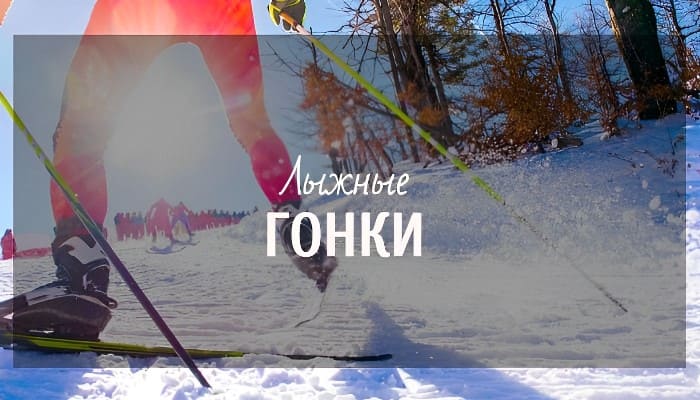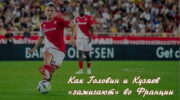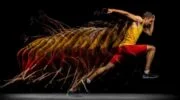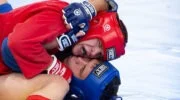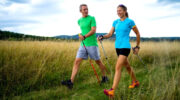In the article “Ski racing” you will learn the history of the sport of skiing, the difference between skating and classic skiing. We will also talk about the peculiarities of equipment.
#SkiRaces #SkiSports #SkiRacing #ProSkiing #WinterSports
Cross-country skiing is an ancient winter pastime dating back thousands of years. Throughout its long and fascinating history, cross-country skiing evolved from a prehistoric mode of transportation and hunting to a set of military exercises before becoming a highly competitive sport.
The first skis were invented by Nordic peoples as a means of moving through deep snow. These peoples included the Scandinavian countries, Russia, and northern China. According to archaeologists, the inhabitants of northern Russia used ski-like objects as early as 6,000 B.C.
The first image of a skier was recorded in the Scandinavian region. A rock painting dating back to 3,500 B.C. in modern Norway depicts a skier with a single pole or stick.
Interesting fact! Ancient skiers used only one stick. The skis themselves were of different lengths, the short ski provided traction and the long one was used to glide through the snow.

Since 1200, countries such as Sweden, Norway and some northern European countries have used ski troops in the armed forces. The first official ski competitions were held in 1767 in Norway.
As ski racing was gaining popularity, competitions began to be held in Sweden and Finland, and later throughout central Europe, ski clubs were opened in many countries.
Not surprisingly, the growing enthusiasm for cross-country skiing was the driver for introducing the sport to the Olympic movement. The first Winter Olympics in 1924 featured men’s cross-country skiing. Women made their debut much later, in the 1952 Oslo Games.
The first World Championship was held in 1924 for men and in 1954 for women. Initially held annually, then every four years, the current format, once every two years, was approved only in 1985.

Since Russia is for the most part a northern region, it is not surprising that our country is one of the leaders in ski racing in terms of the number of medals won. Our athletes won 68 medals at the Olympics, and 167 medals at the World Championships.
The leader of Russia in the number of medals at the Olympics is the Soviet skier Lyubov Ivanovna Egorova. She won 9 Olympic medals, 6 of which were of highest value. Lubov is also a multiple world champion and winner of the 1993 World Cup.
Alexander Bolshunov has all chances to break Egorova’s record of 6 gold medals and Raisa Smetanina’s record of 10 Olympic medals. Currently, our renowned skier has already won 9 medals (3 gold, 4 silver and 2 bronze).
There are several kinds of cross-country skiing races, which are 10, 15, 30 and 50 kilometers for men and 5, 10, 15 and 30 kilometers for women. The winner is determined by the shortest time to complete the course.
In addition to varieties according to the length of the course, there are types of ski races according to the format and style of movement. These include individual and team sprints, relay races, and pursuit races. A complete list of formats can be found in the picture below.

There are two styles of skiing: classic and skate. The classical style has been used by skiers since the first Olympics, but the skate style was officially recognized only in 1986.
Skate style was invented in the 30s of the 20th century, but was considered as a training form of exercise. But after athletes began to use this style to win races with a distinct advantage, it became impossible to ignore it, and since the 1986/87 season, a division into classical and skate distances has appeared.
Classical skiing is sliding down a parallel track with alternating or simultaneous pole pushing. Sometimes this style of skiing is called “Track Walking”.

The skate style is named after the characteristic way of pushing off, just like in skating. The athlete pushes with one foot on the inner edge of the ski, and on the other slides. Then repeats the movement with the other leg. This style of movement is also called “herringbone”.
There are certain rules at cross-country skiing competitions. All participants must have an identification number and have a GPS tracker. The athlete must use basic form skis weighing at least 750 grams per pair. The length of the skis must not be shorter than the skier’s height minus 100 mm.
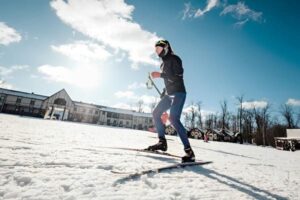
In classic races, the maximum length of the poles should be 83% of the skier’s height, and in skate races, they should not exceed 100% of the skier’s height. The boots and bindings must be of the same design as the production models. No equipment should have hidden springs or other auxiliary elements.
The fastest skis in the world are not made of high-tech plastic or carbon, and from ordinary cardboard, or rather from cellular cardboard. The main advantage of this material is lightweight. It provides the dynamics of the ski, affects the maneuverability and speed.

On a special machine the cardboard honeycomb is pressed with hot liquid graphite. Graphite directly affects the gliding quality of skis. The more graphite is inserted into the ski, the better it glides.
Subsequently, the ski blank is placed in a sturdy edging of wood or plastic. After the layers have bonded, the materials are pressed together. The high temperatures cause the skis to stretch and bend into their classic shape.
In skiing, and even in biathlon, you can’t go far without lubrication. The right ski lubricant is 50% of success, and any lubricator error can cost a medal. Today the speed market has about 50 different ointments, waxes and accelerants. Each stage of gear preparation has its own formula for success, which is kept in the strictest of confidence.

First, a base (neutral) layer of wax is applied to the sliding surface. After curing, the wax is sanded and then the next – the working layer is applied. The properties of the material for the working layer are selected according to the environmental parameters, weather forecast. Usually, experts prepare a few pairs of skis with different lubricants, and the athlete chooses the best option before the race.
In order not to get cold in sub-zero temperatures athletes use a unique underwear, it is a little thicker than 1 mm, but it warms up no worse than a fur coat. In professional thermal underwear, as in the expensive car, individual climate control.
The whole secret lies in a special fabric, the structure of which consists of several hundreds of fibers. The function of a heater is performed by “Thermolight” fiber, and the excess moisture is removed by “Coolmax Extreme”.

At a speed of 25-30 km/h in a strong headwind the intimate area suffers the most. In Soviet times, the function of wind protection was performed by ordinary newspaper, but now functional underwear is used. All thanks to the “windstopper” membrane, which evenly covers the entire surface of sports underwear.
In addition to the World Championships and the Olympics, cross-country skiing has an annual World Cup. The World Cup is won by the skier who earns the most points in the various stages.
For each race, the points are distributed according to the place taken. The maximum number is awarded to the winner (100 points) and the lowest to the 50th place (1 point). In a special stage of the Tour de Ski, the winner receives 300 points and the 50th place winner receives 3 points. In the World Cup Finals and Nordic Opening, athletes receive double points (200 for first and 2 points for 50th).
And, in order to earn points it is necessary to train long and hard. You can be enrolled in skiing from the age of 4-5 years, but experts consider the best age to be 9 years old. If you are a fan of this sport or just want to go skiing, there are no restrictions.
Skiing strengthens and develops endurance, movement coordination, and the ability to keep your balance. In addition, skiing classes take place in the fresh air, so it strengthens the respiratory system and cardiovascular system. Skiing – this is one of the most effective sports for the development of the human body!
About ski racing
FAQs
What is ski racing?
Ski racing is a winter sport in which athletes compete to run a distance on cross-country skis. The minimum distance is 800 meters and the maximum is 70 km.
Who is the most titled skier?
- Marit Bjørgen (Norway) - 15 Olympic medals, 8 of them gold;
- Bjorn Deli (Norway) - 12 Olympic medals, 8 of them gold;
- Lubov Egorova (Russia) - 9 Olympic medals, 6 of them gold;
- Larisa Lazutina (Russia) - 7 Olympic medals, 5 of them gold;
- Johannes Klebo (Norway) - 7 Olympic medals, 5 of them gold.
What is the difference between skating and classic skiing?
- The style of movement. Skating is a style of skiing that resembles speed skating. The skier alternately pushes the inner edge of the ski, and the second slides. This style of movement is also called "herringbone". The classic style of skiing is sliding along a parallel track with alternating or simultaneous pushing the poles. Sometimes this style of movement is called "Track Walking";
- Equipment. The skis for the classic stroke are longer, softer and have a sharper tip. In addition, skate skis have no retention zone, the poles are 17% longer, and the boots are stiffer and higher;
- Speed of learning. Learning to move in the classic style is much easier than the skate style. Skate style requires a well-paved trail, good physical training and good coordination of athlete's movements.

